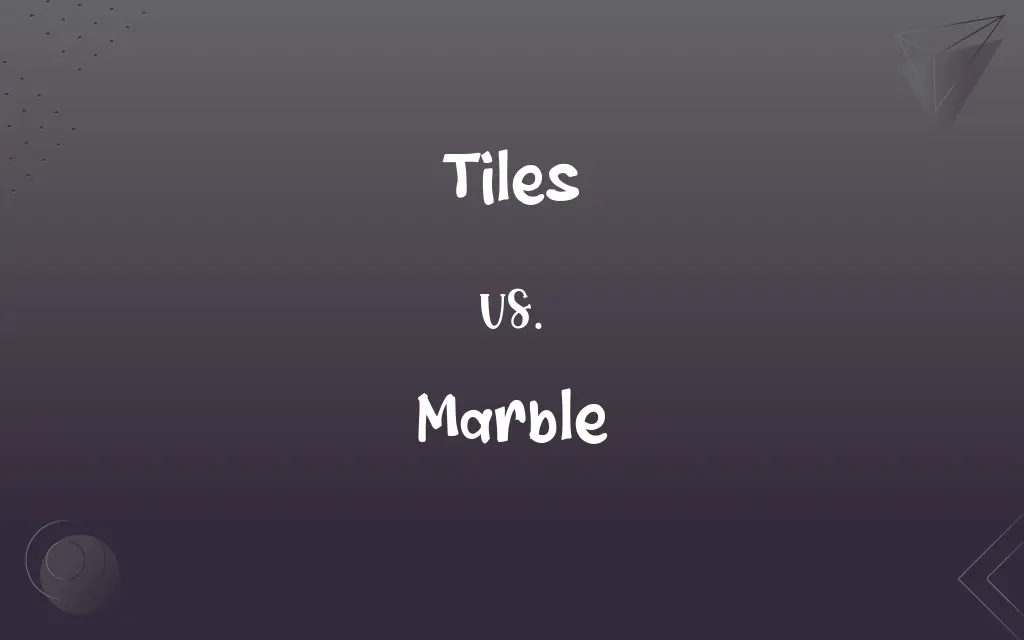Tiles vs. Marble: What's the Difference?
Edited by Aimie Carlson || By Harlon Moss || Updated on October 21, 2023
Tiles are thin pieces of hard material for covering surfaces; marble is a metamorphic rock with veined patterns used for sculpture and construction.

Key Differences
Tiles and marble both serve as materials for covering surfaces, but they differ in origin and appearance. Tiles can be made from various materials like ceramic or porcelain, while marble is a naturally occurring metamorphic rock.
The aesthetic appeal of tiles and marble varies. Tiles can have uniform colors or patterns printed on them, while marble boasts distinct veined patterns unique to each piece.
In terms of durability, tiles, especially porcelain ones, can be highly resistant to wear and tear. Marble, being a natural stone, requires more care to prevent stains and scratches.
Installation methods differ between tiles and marble. Tiles are often placed with the help of grout, ensuring they remain fixed on surfaces. In contrast, marble slabs might need specialized installation due to their weight and size.
Cost considerations between tiles and marble can be significant. While tiles can range in price based on quality and design, marble is often viewed as a luxury material and can command higher prices.
ADVERTISEMENT
Comparison Chart
Material Origin
Man-made, from materials like ceramic or porcelain.
Natural metamorphic rock.
Appearance
Uniform or printed patterns.
Distinct veined patterns.
Durability
Resistant to wear, especially porcelain tiles.
Requires care to prevent stains and scratches.
Installation
Placed with grout.
Needs specialized installation due to weight and size.
Cost
Varies based on quality; can be economical.
Often seen as a luxury material; generally more expensive.
ADVERTISEMENT
Tiles and Marble Definitions
Tiles
Materials used in mosaics.
The artist arranged the tiles in a beautiful pattern.
Marble
Metamorphic rock with veined patterns.
The countertop was made of fine Italian marble.
Tiles
Square or rectangular pieces of baked clay.
The kitchen backsplash features hand-painted tiles.
Marble
A small spherical toy.
The child played a game with glass marbles.
Tiles
Elements in certain games.
She drew three new tiles in the board game.
Marble
To mottle or streak, giving a marbled appearance.
The cake had a marble effect with chocolate and vanilla.
Tiles
Units in digital graphics.
The game’s graphics loaded one set of tiles at a time.
Marble
Material used for sculpture.
The statue was chiseled out of a single block of marble.
Tiles
Thin pieces covering surfaces.
She chose blue tiles for her bathroom floor.
Marble
Indication of quality or luxury.
The hotel's marble foyer was impressive.
Tiles
A thin, flat or convex slab of hard material such as baked clay or plastic, laid in rows to cover walls, floors, and roofs.
Marble
A metamorphic rock formed by alteration of limestone or dolomite, often irregularly colored by impurities, and used especially in architecture and sculpture.
FAQs
Are tiles more cost-effective than marble?
Generally, tiles can be more economical than marble, but prices vary based on quality and design.
Can tiles replicate the look of marble?
Yes, some tiles are designed to mimic the appearance of marble.
Are tiles always made of ceramic?
No, tiles can be made of various materials, including ceramic, porcelain, stone, and more.
Can marble be used in outdoor settings?
Yes, but marble used outdoors requires special treatments to withstand weather conditions.
Does marble scratch easily?
Yes, marble is softer than some other stones and can scratch more easily.
Is marble a sustainable choice for construction?
While marble is natural, quarrying can impact the environment; sustainability depends on sourcing and transportation practices.
Are tiles resistant to water?
Yes, most tiles, especially glazed ones, are resistant to water.
Which is more porous, tiles or marble?
Marble is generally more porous than glazed tiles, making it more susceptible to staining.
Are tiles and marble used only for flooring?
No, both tiles and marble can be used for countertops, walls, and other surfaces.
Can tiles be recycled?
Some tiles, especially those made of glass or certain ceramics, can be recycled.
How is marble's shine maintained?
Marble's shine can be maintained through regular polishing and using pH-neutral cleaners.
Is marble always white?
No, marble comes in various colors, with the veined patterns often influenced by mineral impurities.
How are tiles typically maintained?
Tiles can be cleaned with mild detergent and water, with grout often requiring specialized cleaners.
How is the veined pattern in marble formed?
The veins in marble are formed from mineral impurities like clay, silt, and sand.
Can tiles be used as a heat shield?
Yes, certain tiles, especially ceramic ones, can resist and diffuse heat.
How are tiles typically installed?
Tiles are usually laid out on adhesive mortar and then grouted.
Can tiles withstand heavy foot traffic?
Porcelain tiles are especially durable and can handle heavy foot traffic.
Does marble come in tile form?
Yes, marble can be cut into tiles for flooring, walls, or other surfaces.
Do marble surfaces require sealing?
Yes, to prevent stains and prolong its beauty, marble surfaces often need sealing.
Why is marble a popular choice for sculptures?
Marble's fine grain and luminosity make it ideal for detailed sculptures and carvings.
About Author
Written by
Harlon MossHarlon is a seasoned quality moderator and accomplished content writer for Difference Wiki. An alumnus of the prestigious University of California, he earned his degree in Computer Science. Leveraging his academic background, Harlon brings a meticulous and informed perspective to his work, ensuring content accuracy and excellence.
Edited by
Aimie CarlsonAimie Carlson, holding a master's degree in English literature, is a fervent English language enthusiast. She lends her writing talents to Difference Wiki, a prominent website that specializes in comparisons, offering readers insightful analyses that both captivate and inform.































































